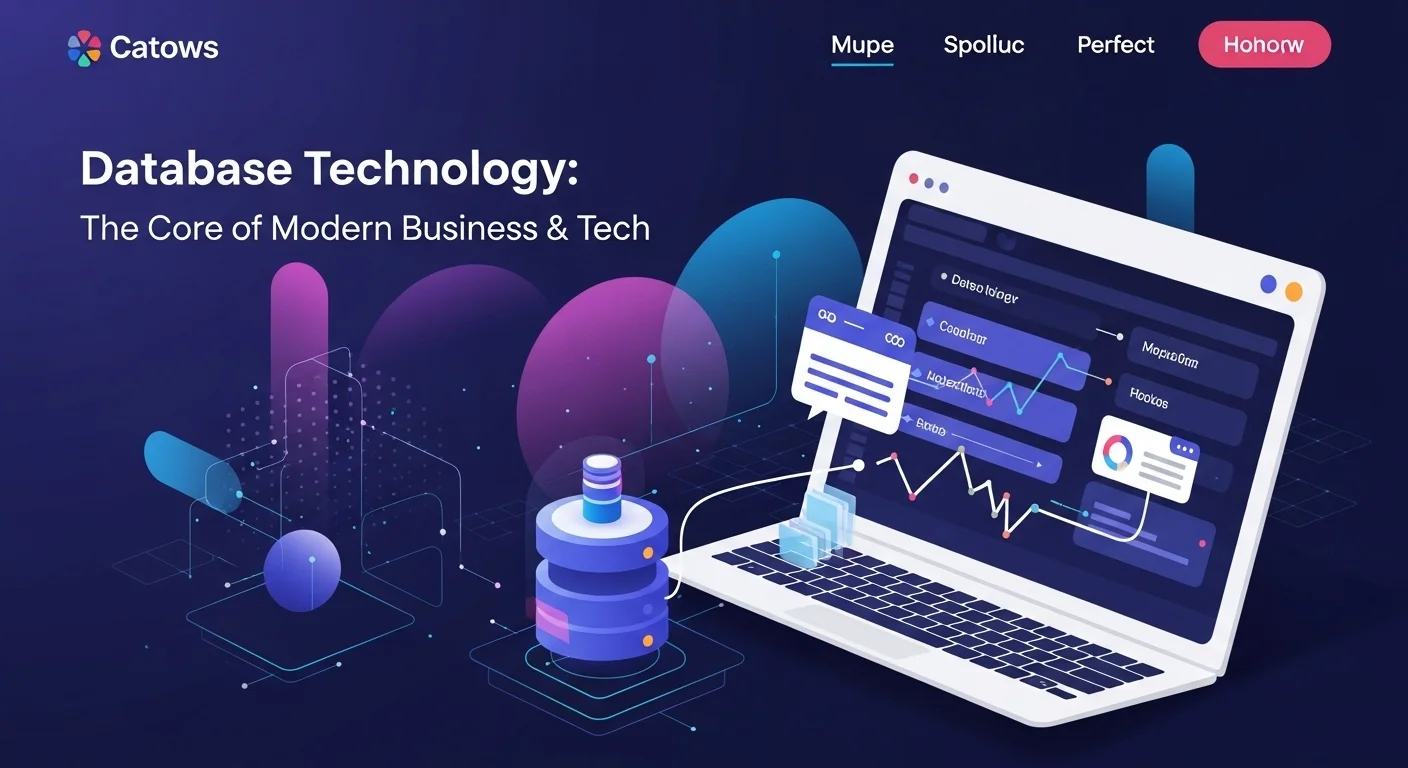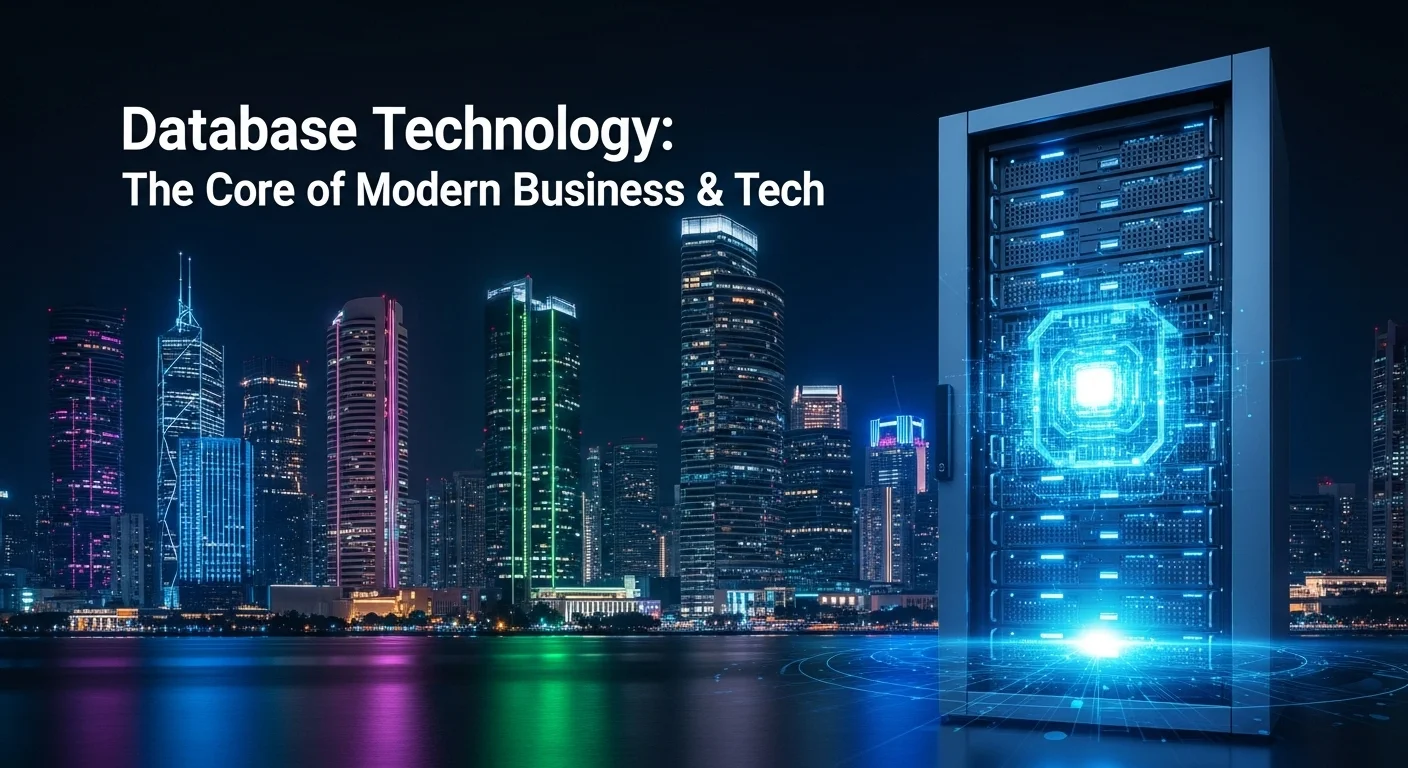What is Database Technology? A Guide to Your Business's Secret Weapon

Executive Summary
In today's digital world, data is everything. But data is just a messy pile of information without a powerful system to organize it. That's where database technology comes in—it's the unsung hero, the digital brain that powers virtually every application you use. For years, I've seen firsthand how the right database can make or break a company. It’s the engine that drives everything from e-commerce sites to the complex AI that's changing our world. In this article, I'll take you on a journey from the basics of what a database is to the advanced solutions that fuel modern business. We’ll explore the game-changing shift to cloud-based systems and managed services (DBaaS) that offer incredible power and flexibility. And because your data is a priceless asset, we’ll dive deep into cybersecurity to show you how to protect it from threats. This isn't just for tech experts; if you're a business leader, understanding these concepts is essential for growth and staying ahead of the curve.
Table of Contents
Table of Contents
- What is a Database and Why is it So Important?
- The Evolution of Databases: From Filing Cabinets to Digital Brains
- Types of Databases: A Look Inside the Toolbox
- The Rise of the Cloud and Its Impact on Databases
- Understanding Database as a Service (DBaaS)
- Why Database Security is Non-Negotiable
- Business Applications: How Databases Drive Success
What is a Database and Why is it So Important?
Behind every tap, click, and transaction you make online, there’s a database working silently in the background. At its core, a database is just a structured collection of data. Think of it as a super-organized digital filing cabinet. But what makes it so powerful is the software that runs it—the Database Management System (DBMS). This system lets you find, update, and manage information almost instantly. I can't overstate how crucial this is. Databases are the foundation of our modern lives, powering social media, online banking, and global supply chains. The journey from clunky old file systems to the sleek databases we have today is one of the biggest leaps in computer science, and it’s what made our data-driven world possible.
The Evolution of Databases: From Filing Cabinets to Digital Brains
In the early days of computing, we stored data in simple text files. It worked, but it was a mess. The same information was often copied in multiple places, leading to inconsistencies, and if you wanted to find something specific, it was a slow, painful process. Changing anything about the data's structure meant you had to rewrite the software—a nightmare for developers. Then, in the 1970s, a brilliant mind named Edgar F. Codd introduced the relational database. This was a complete game-changer. It organized data into neat tables with clear relationships, all manageable with a language called SQL. This brought order to the chaos and became the bedrock for business applications for decades.
Types of Databases: A Look Inside the Toolbox
There's no single database that's perfect for every job. Over the years, I’ve learned that picking the right one is like choosing the right tool from a toolbox. You wouldn't use a hammer to turn a screw. The main choice you'll face today is between SQL and NoSQL databases.
- Relational Databases (SQL): These are the reliable workhorses like MySQL, PostgreSQL, and Microsoft SQL Server. They use a strict, predefined structure, which is fantastic for ensuring data is consistent and accurate. In my experience, any application involving financial transactions or e-commerce orders, where data integrity is paramount, absolutely needs the guarantees that SQL databases provide. They follow strict rules (known as ACID properties) to make sure transactions are completed perfectly every time.
- NoSQL Databases (Non-Relational): As the internet exploded, we started dealing with huge amounts of messy, unstructured data. NoSQL databases were born to handle this chaos. They're flexible, fast, and designed to scale out by simply adding more servers. I remember a project with a social media app that would have choked on a rigid SQL structure; the flexibility of a NoSQL database saved us. There are a few key types:
- Document Stores (like MongoDB): Perfect for content and mobile apps, storing data in flexible JSON-like documents.
- Key-Value Stores (like Redis): Incredibly fast, often used for caching to speed up websites.
- Wide-Column Stores (like Cassandra): Built for massive datasets, a favorite in the Big Data world.
- Graph Databases (like Neo4j): The master of relationships, ideal for social networks and recommendation engines that suggest friends or products.
The Rise of the Cloud and Its Impact on Databases
The biggest shift I've seen in my career is the move to the cloud. It has completely changed how we think about data. Instead of buying and maintaining expensive physical servers, businesses can now rent computing power from providers like AWS, Google, and Microsoft. This has led to powerful new models like cloud-based database software, designed specifically to run in these flexible environments. The benefits are huge: lower upfront costs, the ability to scale up or down on demand, and global reach. It has leveled the playing field, giving startups access to the same powerful technology as giant corporations.
Understanding Database as a Service (DBaaS)
Within the cloud, the most revolutionary idea is Database as a Service (DBaaS). I like to explain it this way: imagine you own a warehouse, but you hire a professional company to manage the building, security, and logistics, so you can just focus on your business. That's DBaaS. The cloud provider handles all the tedious and complex tasks—setup, patching, backups, and scaling. Your team just connects your application and starts using the database. This frees up your developers to focus on building great features instead of wrestling with infrastructure. For any business looking to modernize, adopting managed database services from the cloud is often the smartest, fastest, and most cost-effective move you can make.
Why Database Security is Non-Negotiable
Let's be clear: your database is a treasure chest filled with valuable information, and hackers are modern-day pirates. As we store more sensitive data—from customer details to company secrets—protecting it becomes the top priority. Database cybersecurity is all about defending that treasure from threats like data breaches and malicious attacks. A breach can be devastating, leading to financial loss, a ruined reputation, and legal trouble. That's why a strong security plan isn't an optional feature; it's the foundation of any good database design. It involves multiple layers of defense, like encrypting your data and strictly controlling who can access it. In the cloud, this is a partnership: the provider secures the infrastructure, but you are responsible for securing your data on their platform. Getting this right is fundamental to using database technology safely and effectively.
Business Applications: How Databases Drive Success
Ultimately, the reason we care so much about databases is what they do for a business. They are the backbone of tools that drive growth and efficiency. CRM systems use them to track every customer interaction, helping you deliver personalized service. ERP systems rely on them to manage everything from finance to the supply chain. E-commerce sites couldn't exist without them. The benefits are crystal clear:
- Smarter Decisions: With clean, centralized data, leaders can spot trends and make strategic choices based on facts, not guesswork.
- Streamlined Operations: Automating tasks reduces errors, saves time, and makes the whole business run more smoothly.
- Happier Customers: Understanding your customers allows you to create personalized experiences that build loyalty.
- Growth and Flexibility: Modern cloud databases can grow with your business, so you're always ready for what's next.

The Complete Guide to Database Technology and Business Solutions
Getting your hands dirty with database technology means understanding not just the 'what' and 'why', but the 'how'. I've seen companies soar or stumble based on these decisions. Choosing and implementing the right database solution is a critical moment that affects everything—performance, cost, security, and your ability to scale. This guide is my attempt to give you a clear roadmap, covering the technical choices, business strategies, and essential tools you'll need to build powerful and secure data-driven solutions.
Technical Deep Dive: SQL vs. NoSQL
The first big decision you'll often face is choosing between a traditional SQL database and a more modern NoSQL one. Remember, it’s not about which is universally 'better,' but which is the right tool for the job you need to do.
SQL (Relational) Databases: The Power of Structure
What they are: SQL databases like PostgreSQL and MySQL are all about structure and rules. Data is organized into tables with rows and columns, and you define the relationships between them upfront. This rigidity is their greatest strength, as it guarantees data consistency. You talk to them using Structured Query Language (SQL), a powerful tool for complex queries.
When to use them:
- Financial Systems: I would never build a banking app on anything else. The strict transactional rules (ACID compliance) are essential to ensure money transfers either complete fully or not at all.
- E-commerce Platforms: When you need to manage orders, customers, and inventory, keeping all that data perfectly in sync is crucial.
- Traditional Business Software (ERP, CRM): These systems thrive on the well-defined, structured data and complex reporting that the relational model excels at.
How to think about them: You must design your data structure carefully from the start. This initial planning pays off in the long run with a system that's reliable and easy to maintain.
NoSQL Databases: Built for Flexibility and Scale
What they are: NoSQL databases were created to handle the huge, messy, and fast-moving data of the modern web. They have flexible structures, so you don't have to define everything upfront. Their superpower is horizontal scalability—if you need more power, you just add more servers. It’s a key reason they are a go-to for big data.
When to use them:
- Social Media Feeds: Handling a constant, massive stream of posts, comments, and likes is a perfect job for a NoSQL database.
- IoT (Internet of Things): When you have millions of devices sending sensor data every second, you need the write speed and scale of NoSQL.
- Real-Time Analytics: For things like live dashboards and gaming leaderboards, you need the lightning-fast response times that certain NoSQL databases can provide.
How to think about them: With NoSQL, you model your data based on how your application will ask for it. This is often the reverse of SQL, where you optimize for storage efficiency. The choice of NoSQL type (document, key-value, etc.) will guide your design.
Business Solutions in the Cloud: A Strategic Move
For any new project today, the cloud is the default starting point. It's just smarter business. The speed, cost savings, and continuous innovation from cloud providers have made building your own data center a thing of the past for most companies. The move from buying servers (a capital expense) to paying for what you use (an operational expense) has been a massive driver of this change.
Why You Should Embrace Managed Database Services (DBaaS)
The most transformative business solution is easily Database as a Service (DBaaS). It lets you offload all the painful parts of database management. I've spent countless nights in my career dealing with server maintenance, patching, and backup failures. DBaaS makes those headaches disappear. Your team can get a production-ready database running in minutes with a few clicks.
Who are the leaders?
- Amazon Web Services (AWS): The market leader has a huge menu of options, from Amazon RDS for standard relational databases to DynamoDB for incredibly scalable NoSQL.
- Google Cloud Platform (GCP): Offers powerful services like Cloud SQL, and Cloud Spanner, which uniquely blends the best of SQL and NoSQL for global applications.
- Microsoft Azure: Provides the highly popular Azure SQL Database and Azure Cosmos DB, a versatile NoSQL database that can handle any data model.
The Rise of Cloud-Native Databases
Beyond managed services, we're now seeing cloud-native database software—systems built from the ground up for the cloud. A great example is Snowflake, a data warehouse that brilliantly separates storage from computing power, giving you amazing performance for analytics. Another is Databricks, which combines data lakes and data warehouses into a single 'lakehouse' platform for data and AI. These aren't just databases; they're complete data platforms that help businesses turn data into insights faster than ever before.
Securing the Crown Jewels: A Cybersecurity Framework
With all your data in one place, it becomes a very attractive target. A strong database cybersecurity strategy is not optional; it’s a continuous cycle of identifying threats, putting defenses in place, and watching for anything suspicious.
Common Threats I've Seen in the Wild
- SQL/NoSQL Injection: This is an old trick, but still alarmingly common. It’s like tricking a librarian into giving you books from the restricted section by slipping malicious commands into a legitimate request.
- Insider Threats: Sometimes the call is coming from inside the house. A disgruntled employee or just an honest mistake can lead to massive data loss.
- Data Breaches: Attackers getting in through stolen credentials or by exploiting a security flaw you forgot to patch.
- Denial of Service (DoS): Flooding your database with so much traffic that it becomes unavailable for real users.
- Buffer Overflow: A more technical attack that involves sending too much data to a memory buffer to crash the system or run malicious code.
A Practical Framework for Database Security
Building a strong defense requires layers. Here are the best practices I insist on for any project, integrating database security into your overall cybersecurity plan.
- Access Control: Follow the principle of least privilege. It’s simple: don't give anyone the master key unless they absolutely need it. Grant users and apps only the permissions they need to do their job. Always use strong passwords and Multi-Factor Authentication (MFA).
- Encryption: Your data should be unreadable to thieves. Encrypt it both 'at rest' (when it's stored on a disk) and 'in transit' (when it's moving across the network). This is your data's armor.
- Network Security: Keep your database in a protected part of your network. Use firewalls and virtual private clouds (VPCs) to build a digital fortress around it. Only allow connections from trusted application servers.
- Auditing and Monitoring: You can't stop what you can't see. Log all access and important actions. Use Database Activity Monitoring (DAM) tools to watch for strange behavior in real-time and alert you to potential threats.
- Patch Management: Keep your software updated. Attackers love to exploit known vulnerabilities in unpatched software. Make regular patching a routine habit.
- Secure Backups: Don't forget to protect your escape plan. Your backups should also be encrypted and stored securely. And please, test your disaster recovery plan regularly to make sure you can actually restore your data when you need it most.
By putting these strategies into practice, you can build a data infrastructure that is powerful, scalable, and secure—a solid foundation for your business to grow on.

Tips and Strategies to Master Your Database Experience
Getting good at database technology is a marathon, not a sprint. The landscape is always changing, and your strategies have to evolve with it. Over the years, I've gathered a collection of practical tips and best practices that have saved me and my teams countless hours and headaches. This section is all about sharing that hard-won knowledge with you, from tuning performance to preparing for the future of data. Whether you’re writing code, managing IT, or leading a business, these insights will help you get more value from your data.
Best Practices for Peak Performance and Resilience
A great database is fast, reliable, and secure. That doesn't happen by accident. It's the result of continuous effort and sticking to proven best practices.
1. Performance Tuning and Monitoring
A slow database kills user experience and can bring a business to its knees. Here’s how to keep it running fast.
- Master Your Indexing Strategy: Think of an index like the index in the back of a textbook—it makes finding information incredibly fast. Properly indexing the columns you search on most often is the single best way to boost read performance. But be careful not to over-index, as each index slows down write operations (like adding or updating data).
- Optimize Your Queries: Get familiar with your database's query analysis tools (like `EXPLAIN` in SQL). These show you exactly how a query is being run and where the bottlenecks are. I've seen simple query rewrites cut execution time from minutes to milliseconds.
- Use Connection Pooling: Opening a new connection to a database is expensive. Connection pooling keeps a set of open connections ready to be reused, which dramatically reduces latency for busy applications.
- Monitor Everything: Use tools to keep an eye on key metrics like CPU, memory, disk activity, and query times. Set up alerts so you know about a problem before your users do.
2. Data Backup and Disaster Recovery
Losing data can be a company-ending event. A solid backup and disaster recovery (DR) plan is your non-negotiable insurance policy.
- Automate Your Backups: Backups should be frequent and fully automated. How often you back up depends on how much data you can afford to lose (your Recovery Point Objective). For critical systems, this could be every hour or even continuously.
- Test Your Restores! This is the one I shout from the rooftops. A backup is worthless if you can't restore it. I once saw a company lose a full day of sales because their 'successful' backups were actually corrupted. They never made that mistake again. Don't be that company. Regularly test your recovery process.
- Go for Geographic Redundancy: Store your backups in a different physical location (or a different cloud region) from your main database. This protects you from disasters like fires, floods, or entire data center outages.
- Use Immutable Backups: To defend against ransomware, use storage that makes your backups unchangeable for a set period. This ensures that even if an attacker gets in, they can't delete your escape hatch.
3. Best Practices for Cloud Database Management
Working in the cloud is amazing, but it comes with its own set of rules. When using cloud-based database software or a managed service, here’s what I recommend.
- Right-Size Your Resources: The cloud's elasticity is its superpower. Monitor your usage and adjust your resources (CPU, RAM) to match demand. This is crucial for controlling costs. Don't pay for power you aren't using.
- Let the Provider Do the Heavy Lifting: You're paying for a managed service, so use it! Let the cloud provider handle backups, patching, and failover. I've seen teams waste time trying to reinvent the wheel when a better solution was just a checkbox away.
- Know Your Responsibility: Always remember the Shared Responsibility Model. The provider secures the cloud, but you are responsible for security *in* the cloud. That means you have to configure your firewalls, network access, and user permissions correctly.
Essential Tools from My Personal Toolkit
The right tools make any job easier. Here are a few categories of tools I rely on daily:
- Database Management GUIs: These give you a visual way to interact with your database. DBeaver is a fantastic universal open-source tool, while Navicat is a powerful commercial option. For specific databases, tools like pgAdmin for PostgreSQL and MySQL Workbench are indispensable.
- Monitoring and Observability Platforms: To get deep insights, I use platforms like Datadog, New Relic, or the open-source Prometheus/Grafana stack. They help you connect database performance to application behavior, which is a lifesaver for troubleshooting.
- Schema Migration Tools: For development teams, tools like Flyway and Liquibase are essential. They let you manage and version your database schema changes just like you version your code, ensuring consistency across all your environments.
Expert Resource Recommendation: For anyone serious about cloud databases, I highly recommend the AWS Database Blog. It’s filled with articles and case studies from the people running one of the world's largest collections of database services.
Future-Proofing Your Data Strategy: What's on the Horizon
The database world never stands still. Keeping an eye on what's next will help you make smarter decisions today.
- AI-Powered Database Management: AI is coming for database administration. We're seeing autonomous databases that can tune, patch, and secure themselves. AI-driven query optimizers that learn from your usage patterns are already here and getting better every day.
- Vector Databases for the AI Revolution: The explosion of generative AI like ChatGPT has created a need for a new kind of database. Vector databases are built to store and search the numerical representations of data (like text and images), powering semantic search, recommendation engines, and more. This is a very hot space right now.
- Serverless Databases: This is the next evolution of DBaaS. Serverless databases scale up and down automatically—even to zero—based on demand. You truly only pay for the queries you run, making them incredibly cost-effective for apps with unpredictable traffic.
- Data Mesh and Data Fabric: These are new architectural ideas for large organizations struggling with massive amounts of data. Data Mesh gives ownership of data to specific business teams, treating 'data as a product.' Data Fabric aims to create a smart, unified layer over all your disparate data sources.
- Next-Generation Cybersecurity: As threats evolve, so must our defenses. The future of database security will rely heavily on AI to detect threats proactively, along with more advanced encryption and data masking to keep sensitive information safe.
By embracing these tips and keeping an eye on the future, you can build a data foundation that is not only robust and efficient today but is also ready for the opportunities and challenges of tomorrow.
Expert Reviews & Testimonials
Sarah Johnson, Business Owner ⭐⭐⭐⭐
As a small business owner, I found this article very insightful. It helped me understand why migrating to a cloud database isn't as scary as it sounds. I would have loved a case study on a similar-sized business, but overall, it's a great starting point.
Mike Chen, IT Consultant ⭐⭐⭐⭐⭐
A solid overview of database tech. I work with clients on this daily, and the breakdown of SQL vs. NoSQL was spot on. The section on DBaaS will be particularly useful for explaining the benefits to less technical stakeholders. Well done.
Emma Davis, Tech Student ⭐⭐⭐⭐⭐
Finally! An article that connects all the dots. I've been studying for my cloud certification, and this piece clarified the 'why' behind so many concepts, especially the shared responsibility model in security. This is one I'll be bookmarking and sharing with my study group. Fantastic resource!



